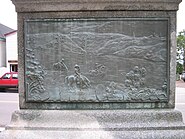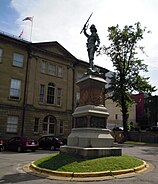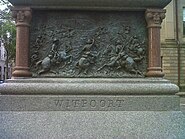| Harold Lothrop Borden | |
|---|---|
 Harold Lothorp Borden | |
| Born | May 23, 1876 |
| Died | 16 July 1900 (aged 24) |
| Place of birth | Canning, Nova Scotia |
| Place of death | Witpoort, South Africa |
| Buried at | Braamfontein Cemetery, Brakpan, Greater Johannesburg, South Africa |
| Allegiance | Britain |
| Rank | Lieutenant |
| Battles/wars |
|
Lieutenant Harold Lothrop Borden, (23 May 1876 – 16 July 1900) was from Canning, Nova Scotia and the only son of Canada's Minister of Militia and Defence, Frederick William Borden. Serving in the Royal Canadian Dragoons, he became the most famous Canadian casualty of the Second Boer War.[1] Queen Victoria asked F. W. Borden for a photograph of his son, Prime Minister Wilfrid Laurier praised his services, tributes arrived from across Canada, and in his home town a monument (by Hamilton MacCarthy) was erected to his memory.[2]
Military career[]
Sir Frederick Borden - While Canadian Minister of Defence, his only son Harold was killed in war
Bordon's military career began in 1893, when he entered the King's Canadian Hussars. In 1897, as a member of Queen Victoria's Diamond Jubilee Contingent he received the Jubilee Medal. By 1899 he rose to Major in command of this corps. At the outbreak of the Second Boer War Borden received a commission as Lieutenant with the 1st Regiment, Canadian Mounted Rifles (which shortly after his death became known as the Royal Canadian Dragoons) and allotted to the 1st Battalion, "B" Squadron as Officer Commanding the 4th Troop. He was brought to the attention of Field Marshal Lord Roberts', the British commander-in-chief in South Africa, for repeatedly swimming with Richard Turner across the Vet River at Coetzee's Drift, to draw the fire of the Boers who were dug in on the north bank (5 May 1900).[3]
Borden also fought with distinction at the Battle of Faber's Put (30 May 1900). The battle was one of the most desperate actions faced by Canadians while campaigning in South Africa: 27 killed, 41 wounded, and the loss of a large number of horses. Field Marshal Lord Roberts reported: “Lieut. H. L. Borden, gallant conduct in swimming the Vet River under fire, 5th May, and in capturing some of the enemy’s wagons on 30th May.” [4]
The death of Lieutenant Harold Lothrop Borden at Witpoort on 16 July 1900 occurred when Lieutenant John Edgar Burch and he, while assisting the Royal Irish Fusiliers and some New Zealanders withstand a Boer assault on Witpoort ridge, led a counter-attack. It was successful but Boer marksmen, standing less than 200 metres away, shot them as they stood up to lead the assault. Lord Roberts reported to the War Office that Borden and Burch "were killed while gallantly leading their men in a counter attack upon the enemy's flank at a critical juncture of his assault upon our position." [5]
Legacy[]
Bordon is commorated with various monuments and plaques. In his home town, Canning, Nova Scotia is a statue by Hamilton MacCarthy. In Halifax, Nova Scotia the base of the South African War Memorial has a panel commemorating the Battle of Witpoort. There is also a memorial plaque to Bordon at McGill University, Montreal in the Srathcona Anatomy and Dentistry Building, where Borden was a medical student before joining the war effort. Finally, there is also a plaque to Borden and others who died at Witpoort at Braamfontein Cemetery in South Africa where he is buried.
Gallery[]
Further reading[]
- Panagos, D.C. (October 1999). "Witpoort, 16 July 1900: Traces of an Anglo-Boer War battle". ISSN 0026-4016. http://samilitaryhistory.org/vol113dp.html.
See also[]
References[]
External links[]
- Image of Monument to British Soldiers who died in Battle of Witpoort
- Harold Borden Story
- Memorial plaque, Srathcona Anatomy and Dentistry Building, McGill University, Montreal
- Battle of Cortzee Drift
- "Harold Lothrop Borden". Dictionary of Canadian Biography (online ed.). University of Toronto Press. 1979–2005.
- Battle of Faber's Put
The original article can be found at Harold Lothrop Borden and the edit history here.




